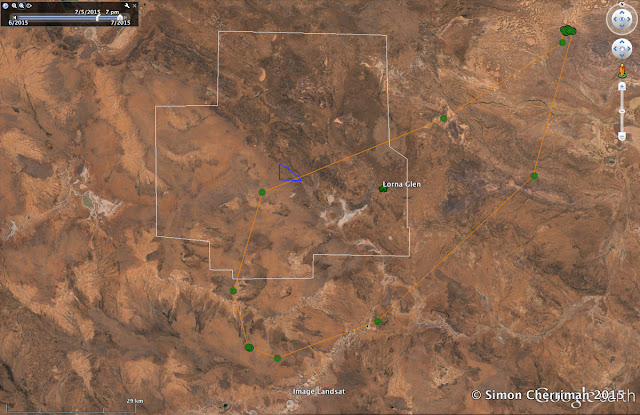
This website has been set up as part of a community education project which allows YOU to follow the movements of Wallu, the first ever Wedge-tailed Eagle to be satellite tracked, and other eagles subsequently satellite-tagged in Western Australia. This exciting and pioneering study, which now forms part of Simon Cherriman's PhD project, aims to shed light on aspects of a unique Australian eagles' ecology which have never before been researched.
Monday, 6 July 2015
A New Nest?
As the eagle breeding season approaches, I've been tracking the daily movements of our male wedgie Wallu, and paying particular attention to where he has roosted each night. In the last 2 weeks he has spent more than half of his nights at a particular tall gum-tree in a small patch of woodland about 700 m north-east of his favourite rabbit warren hunting place. This is shown by the cluster of GPS fixes in the above picture (click to enlarge). I have inspected this site a few times in the past year and discovered the perch tree is a tall Cue York Gum (Eucalyptus striaticalyx) with quite a few nice horizontal perches, perfect for eagles to land on. When not roosting at the actual tree, Wallu has still remained close by, spending every night within a 1 km radius of it. It has been interesting to observe a shift in his behaviour - over the summer period he often roosts in tall Gidgee trees on the high ridge that forms the northern border of his territory, close to his two existing nest sites, and only visits the Rabbit Ridge every few days.
The fact Wallu has spent an increasing amount of time in this area as Wedge-tailed Eagles are preparing to breed makes me think him and Wurru have built a new nest here. When I learned how often he visits the nearby rabbit warren, I did wonder why this pair persisted at attempting to breed (and subsequently failing) in nests which were so far from their apparent key source of food. It would make sense to build at a site much closer to an abundant and readily portable supply of prey. I am very much looking forward to visiting the territory later this year to see if my prediction is right!
Friday, 3 July 2015
Home Run
Kuyurnpa has continued her urge to return home! After her recent long journey south, she stopped to rest for a few days 70 km north-east of her natal territory (scroll down to read more). In the next 2 days the satellite tracking data showed her head south-west from here and, around 2 pm on 2nd July, pass right above the nest on which she hatched nearly 2 years ago. Kuyurnpa then flew directly south and roosted not far from the site where she spent her first ever night alone (on 29th March 2014), clocking up 115 km for that day. By dusk tonight (3rd July 2015), she was back at the northern roost site again, completing a 2 day, 230 km 'home run' loop. Does this behaviour indicate she is wanting to return home, or is searching for a vacant breeding territory near where she was born? I still feel it is a little early for Kuyurnpa to breed, and although we know from the CSIRO's work in the 1970's that most breeding eagles are adults aged more than 6 years, we have no data on when Wedge-tailed Eagles might begin their settlement. We will only gather some insight by continuing to track Where Eagles Dare - and you can assist with that by pledging your support to help this eagle tracking project continue. Visit the Crowdfunding Campaign for information on how you can help!
Wednesday, 1 July 2015
230 Clicks South
Kuyurnpa has in the last week been on the wing again, clocking up more remarkable kilometres during a sudden journey southward. Our young eagle, who is approaching her 2nd birthday next month, added 460 km to her odometer in a 4-day flight that saw her leave Roy Hill and fly back towards home soil. On one of these days, Kuyurnpa moved an amazing 230 km between 10 am and 4 pm, with one GPS fix recording her travelling at just over 90 km per hour! Just when I thought she might settle in the Pilbara region for a while (Kuyu has just spent 6 consecutive months on an area of Roy Hill that is approximately 100 km wide), this wandering wedgie has zipped across to the Gascoyne region, stopping about 70 km north-east of her natal territory. This is the closest she's been to her 'home' since roosting 60 km away from it on 27th October last year. Will she stay here longer, or will she continue to move on? The only way to know is to check in again soon!
Don't forget to view the video to the Crowdfunding Campaign I launched just over 2 weeks ago, where you can pledge your support to help this eagle tracking project continue.
 |
| Kuyurnpa's journey south south-east, showing 4 days travel. |
Subscribe to:
Comments (Atom)


